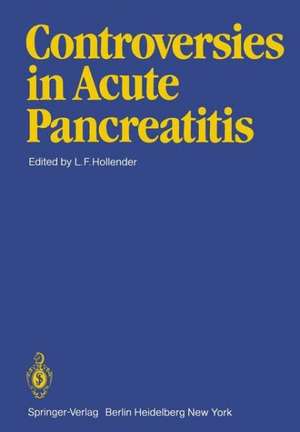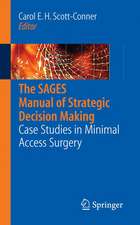Controversies in Acute Pancreatitis
Editat de L. F. Hollenderen Limba Engleză Paperback – 31 mai 1982
Preț: 722.69 lei
Preț vechi: 760.73 lei
-5% Nou
Puncte Express: 1084
Preț estimativ în valută:
138.28€ • 144.77$ • 114.42£
138.28€ • 144.77$ • 114.42£
Carte tipărită la comandă
Livrare economică 05-19 aprilie
Preluare comenzi: 021 569.72.76
Specificații
ISBN-13: 9783540114109
ISBN-10: 3540114106
Pagini: 368
Ilustrații: XVII, 344 p. 30 illus.
Dimensiuni: 170 x 244 x 19 mm
Greutate: 0.59 kg
Ediția:Softcover reprint of the original 1st ed. 1982
Editura: Springer Berlin, Heidelberg
Colecția Springer
Locul publicării:Berlin, Heidelberg, Germany
ISBN-10: 3540114106
Pagini: 368
Ilustrații: XVII, 344 p. 30 illus.
Dimensiuni: 170 x 244 x 19 mm
Greutate: 0.59 kg
Ediția:Softcover reprint of the original 1st ed. 1982
Editura: Springer Berlin, Heidelberg
Colecția Springer
Locul publicării:Berlin, Heidelberg, Germany
Public țintă
ResearchDescriere
The first complete general study of acute necrotizing hemorrhagic pan creatitis was made in 1889 by Reginald Fitz. If we survey the therapeutic evolution of this severe illness, we may briefly summarize it into three pe riods: (a) resolutely surgical treatment, from approximately 1880 to 1938; (b) much more conservative treatment, from 1938 to 1963; and (c) a return to surgery, from 1963 onward. Hoffmann, in 1911, was probably the first to advocate the removal of the necrotic portion of the pancreas. In 1933, Okinczyc wrote: "The ope rative indications are not a matter for discussion; emergency surgery must be quick to manage the patient's poor resistance." So: "go right to the target, expose, drain ... and hope!" Leriche and Arnaud, more inge nious, said: "The aim of the operation is to avoid diffusion of the pan creatic juice into the abdominal cavity and limit the harmful effects of what remains in situ ... " With the progress in intensive care techniques, the "conservatives" emphasizing the poor results of surgery had no difficulty in imposing their point of view. Subsequently, in 1963, a new period began with the first successful emergency pancreatoduodenectomy, performed by Watts. If nowadays surgery for the secondary stage of necrosis or abscesses is generally accepted, emergency surgery still remains questionable even if not systematically refused. Many surgeons perform it under three condi tions: the worsening of the patient's general state despite medical treat ment, a dubious diagnosis, and a biliary etiology.
Cuprins
Does Incompetence of the Sphincter of Oddi Exist? Can It Account for Certain Cases of Acute Pancreatitis?.- Pancreatic Duct Reflux and Acute Pancreatitis.- Can Pancreaticoduodenal Reflux Explain Acute Pancreatitis? Yes, in Some Cases.- The Role of Biliary Millilithiasis in the Pathogenesis of Acute Pancreatitis.- Hemodynamic and Metabolic Impairment in Acute Pancreatitis.- Acute Pancreatitis Following Transduodenal Sphincterotomy.- Discussion.- Controversies in the Biological Diagnosis of Acute Pancreatitis.- The Cause of Hypophosphatemia in Acute Pancreatitis.- Fibronectin as a Prognostic Parameter in Patients Suffering from Pancreatogenic Shock.- The P3 Index in Acute Pancreatitis.- The Amylase to Creatinine Clearance Ratio.- Interest of Measuring Plasmatic and Urinary Lipase Activity in Pancreatic Disorders.- Ultrasonic Diagnosis of Acute Pancreatitis.- Contribution of Computed Tomography in the Diagnosis of Severe Acute Pancreatitis.- Possibilities and Limits of Sonography in Acute Pancreatitis.- Computed Tomography and Clinical Severity of Acute Pancreatitis.- Computed Tomography and Acute Pancreatitis.- Computer Tomography and Prognostics of Acute Pancreatitis.- Retrospective Value of Diagnostic Procedures in Acute Pancreatitis.- Computed Tomography and Anatomical Comparisons in Acute Pancreatitis.- Possibilities and Limits of Computed Tomography.- Contribution of Computed Tomography in the Management of Acute Necrotizing Pancreatitis.- Peritoneal Lavage for the Diagnosis and Prognosis of Acute Pancreatitis.- What can be Expected of Laparoscopy in the Diagnosis of Acute Pancreatitis?.- Objective Prognostic Evaluation of Patients with Acute Pancreatitis.- Prognostic Signs in Acute Pancreatitis.- Prognostic Value of Nystagmus in the Evolution of Acute Pancreatitis.- Pancreatic Necrosis and Acute Pancreatitis.- Functional Cardiorespiratory Patterns in Acute Pancreatitis.- Histopathology of Experimental Pancreatitis of Ductal Origin.- Current Status of Diagnosis and Conservative Treatment of Acute Pancreatitis.- Anatomopathological Findings in Acute Pancreatitis.- Acute Necrotic Pancreatitis: Anatomosurgical Correlations and Therapeutic Deductions.- Proteinase Inhibitors of Microbial Origin in the Treatment of Experimental Acute Haemorrhagic Pancreatitis.- Relationship of Glucagon to Exocrine Pancreatic Secretion and Its Use in Acute Pancreatitis.- Treatment of Acute Pancreatitis with Somatostatin. A Randomized Study.- Trypsinogen and Trypsin in Acute Pancreatitis. Physiopathology.- A Prospective Study to Determine the Efficacy of Dextran 40 in Acute Pancreatitis.- Our Experience in the Treatment of Acute Necrotizing Hemorrhagic Pancreatitis.- Acute Pancreatitis: Results of 42 Observations.- Acute Pancreatitis. Retrospective Study of 225 Cases.- Points of View on Necrosis in Acute Pancreatitis.- Peritoneal Lavage in Acute Pancreatitis.- Our Experience with Drainage-Lavage of the Peritoneal Cavity.- A Controlled Randomized Study on the Value of Peritoneal Lavage in Acute Pancreatitis (an Interim Report).- Therapeutic Peritoneal Lavage.- Peritoneal Dialysis in Acute Necrotic-Hemorrhagic Pancreatitis.- Acute Hemorrhagic-Necrotic Pancreatitis: Laparotomy or Peritoneal Lavage? Results of a Randomized Controlled Clinical Study.- Controversies in Acute Pancreatitis.- Endoscopic Papillotomy as a Therapeutic Alternative in Acute Biliary Pancreatitis.- Endoscopic Sphincterotomy in Acute Biliary Pancreatitis.- Endoscopic Sphincterotomy in Acute Pancreatitis.- Possibilities and Limits of Intensive Care in Acute Necrotic Pancreatitis.- Controversies in Possibilities and Limits of Intensive Care. Conclusions.- Acute Pancreatitis: Controversial Operative Indications.- Our Criteria for Surgical Intervention in Acute Necrotizing Pancreatitis.- Controversies in Surgical Indications.- Results of Exeresis in Acute Necrotico-hemorrhagic Pancreatitis.- Choice of Treatment in Acute Pancreatitis.- Surgical Treatment of Acute Necrotizing Pancreatitis: A Series of 30 Cases.- Surgical Treatment of Acute Necrotizing Hemorrhagic Pancreatitis: A Series of 46 Cases.- Acute Pancreatitis: Conservative Attitude, Expectant Vigilance.- Acute Pancreatitis: Results and Strategy of Operative Treatment.- Role of Total Pancreatectomy in the Treatment of Acute Necrotizing Pancreatitis. Indications and Results of 22 Cases.- Early and Iterative Interventions in Cases of Acute Necrotizing Pancreatitis: An Answer to the Absence of Correlation Between Their Anatomical and Clinical Expressions.- Enteral Nutrition by Alimentation Jejunostomy in 11 Cases of Severe Acute Pancreatitis.- The Role of Artificial Nutrition in the Treatment of Acute Pancreatitis.- Role of Complete Parenteral Treatment Nutrition in Acute Pancreatitis.- Amino Acid Metabolism in Acute Necrotizing Pancreatitis. Aspects of Parenteral Nutrition.- Secondary Colonic Lesions in Acute Pancreatitis.- Necrotizing Colitis and Acute Necrotizing Pancreatitis. Report of Eight Cases. Role of Shock.- Problems in the Management of Pancreatic Abscesses.- Treatment of Pancreatic Abscess.- Treatment of Fistulas Following Laparotomy for Acute Pancreatitis.- General Conclusions and Adoption of a Diagnostic and Therapeutic Programme for the Future.






